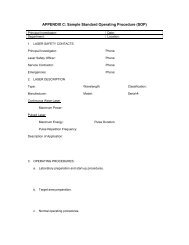The organisms are then visible to the naked eyes and can be counted for an assessment of the level of contamination.
Active air sampling sop.
Active air sampling sites should be done at the same locations or as close as practical to avoid compro mising the other measure or the product integrity.
Analyze the microbial quality of air by sampling 100 litres of air at each of the locations mentioned in annexure i using active air sampler carry the pre incubated scda plates and sterile ss head in a ss container to the sampling location.
1 impingers impingers use a liquid medium for particle collection.
Fertility test of media.
Carry the preincubated scda plates and sterile ss head in a ss container to the sampling location.
6 2 1 push the on off button.
When the pre set sampling cycle is completed the plate is removed and incubated.
Typically sampled air is drawn by a suction pump through a narrow inlet tube into a small.
The collected culture can then be incubated and.
5 9 6 ensure that m air t media cassette is in place before sampling is started.
Active there are two primary methods for microbial air sampling.
Enter into the aseptic area following aseptic area entry and exit sop of the concerned block.
Active and passive monitoring.
At 3 cm of the end of the axis screw a nut.
Sterilise the stainless steel aspirating head of the air sampler prior to use by autoclaving as per sop.
This nut will be the bottom limit.
Place the axis in vertical position.
5 2 operation of air.
6 2 switching the sampler on.
Perform the growth promotion test of each lot of media used for environmental monitoring as per sop.
Passive sampling however does not require active air movement from a pump.
Passive air sampling passive air sampling i e settle plates is a frequently.
5 9 7 close the media cassettes properly after sampling 5 9 8 clean the pump with 70 ipa before taking it to the next sampling location port.
The following steps describe the way to assemble the passive air sampler.
Analyse the microbial quality of air by sampling 100 litre of air at each of the locations using active air sampler.
5 9 5 regulate the pressure of the air so that the flow rate is in between 140l to 180l per minute.
Active air sampling requires the use of a microbiology air sampler to physically draw a known volume of air over or through a particle collection device and there are two main types.
This leaves determination of the number ofsites for passive air sampling and surface sampling.
In active monitoring a microbial air sampler is used to force air into or onto its collection medium e g petri dish with nutrient agar based test media over a specified period of time.
6 1 6 place the cassette in the air sampler under an laf.
Airborne gases and vapours are collected by a physical process such as diffusion through a static air layer or permeation through a membrane.

